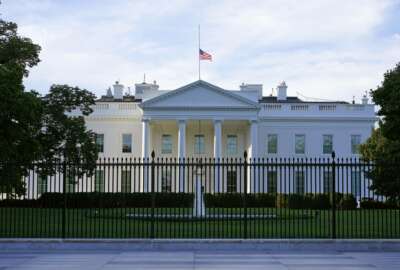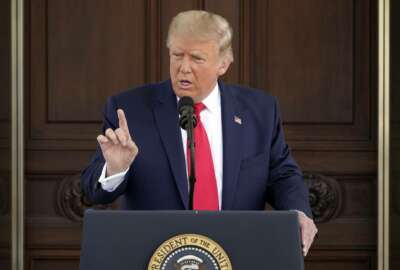

Hubbard Radio Washington DC, LLC. All rights reserved. This website is not intended for users located within the European Economic Area.
It'll be up to political appointees to determine whether agency diversity and inclusion training runs afoul of the president's recent executive order on "divisi...
Best listening experience is on Chrome, Firefox or Safari. Subscribe to Federal Drive’s daily audio interviews on Apple Podcasts or PodcastOne.
The president’s recent executive order banning certain types of diversity and inclusion training in federal agencies has sparked all kinds of questions and some confusion for the federal community.
For agency senior leaders and federal employees, the EO, which the president released last week, poses many questions about whether they’ll need to alter their diversity and inclusion programs to conform with the language in the order — or risk discipline and an adverse action if they fail to do so.
The EO poses similar questions and doubts for federal employment attorneys, who — depending on how agencies implement the order — may eventually defend those leaders and employees from adverse actions and discipline.
The EO, which is the administration billed as an “executive order on combatting race and stereotyping,” bans agencies from adopting “training, workshops, forums or similar programming” that teaches or advocates any of the “divisive concepts” listed in the order:
Agency heads are supposed to issue an order incorporating the requirements of the EO into organizational operations, and inspectors general are supposed to annually review agencies’ compliance with it. The executive order also has implications for federal contractors and grantees.
But whether the EO will have an impact on agency operations may ultimately depend on the perceptions, experiences and biases of individual employees and managers — and the agency officials who, according to this order, have the authority to discipline them.
As its written, the EO’s language may pose confusion for diversity and inclusion managers, many of whom may look at their own agencies’ programs and believe their training doesn’t come close to the “divisive topics” described in the order,” Reginald Wells, a former chief human capital officer with the Social Security Administration and a current lecturer at American University’s School of Public Affairs, said in an interview.
“On the one hand [the EO] talks about ideals that have always been there. And then it seems to turn those things on their head,” he said. “It just doesn’t seem to be consistent in its message. I kept feeling like there were multiple messages in one document, which paralyzes people when they start thinking about, ‘How do I stay in conformance with this and accomplish those things without riding a ragged edge that I could end up getting disciplined for?'”
Both the executive order and subsequent implementation guidance the Office of Management and Budget released Monday afternoon say the EO doesn’t prevent agencies from promoting diversity and inclusiveness.
Training can still occur, but a senior political appointee from each agency must approve any spending on it. It’ll be up to those appointees to determine whether training meets the “standard of fair and equal treatment of individuals” and what programs run afoul of the EO, OMB said.
“The president and the administration believe the fair and equal treatment of individuals is an inviolable principle that must be maintained in the federal workplace,” OMB Director Russ Vought said in Monday’s new guidance. “Agencies should continue all training that will foster a workplace that is respectful of all employees.”
To help determine whether training should be discontinued, agencies should review their curricula, as well as financial and procurement data, for terms such as “critical race theory,” “white privilege,” “intersectionality,” “systemic racism,” “positionality,” “racial humility” and “unconscious bias,” among others, OMB said.
Yet the EO has baffled federal employment attorneys, who say they can’t imagine a scenario where an employee or supervisor receives discipline for deploying a training session that an agency official might disagree with.
Many of the “divisive concepts” described in the EO are unobjectionable, George Chuzi, a partner with the law firm Kalijarvi, Chuzi, Newman & Fitch, said in an interview.
Few equal employment opportunity professionals in government would agree, to use the EO’s language, that “one race or sex is inherently superior to another race or sex,” or “an individual should be discriminated against or receive adverse treatment solely or partly because of his or her race or sex,” Chuzi said.
“It’s so vague that it’s difficult to understand what they really want to do other than make it more difficult to conduct training,” he said. “This is obviously going to be an intimidating issue for anybody involved in diversity and inclusion. But it’s going to make it much more difficult for people to conduct those training sessions.”
The examples the administration included in the executive order may not help agency diversity and inclusion managers, either.
The EO cites a recent seminar at the Treasury Department, which “promoted arguments that ‘virtually all White people, regardless of how ‘woke’ they are, contribute to racism,’ and that instructed small group leaders to encourage employees to avoid ‘narratives’ that Americans should ‘be more color-blind’ or ‘let people’s skills and personalities be what differentiates them.'”
The order cited other examples at two national laboratories and a Smithsonian museum. Training materials from Argonne National Laboratories, according to the EO, “stated that racism ‘is interwoven into every fabric of America’ and described statements like ‘color blindness’ and the ‘meritocracy’ as ‘actions of bias.'”
Wells said he had never participated in or implemented the training material like the EO described. It evolved over time from an equal employment opportunity compliance exercise to one that focused more on professional development and education, and it addressed everything from bullying and stereotypes about body image and ableism to racism and sexism, he said.
“Given the diversity and inclusion programs that I presided over and that I believe are still going on in many places in government, in my interpretation it would not be in conflict with the president’s executive order,” Wells said. “The kinds of very divisive things that are portrayed in the executive order, to the best of my knowledge, none of our training went to those places. It was about trying to uplift everybody. It was about trying to speak to the equality that ought to be there.”
The president’s recent executive order stems from a memo OMB released earlier this month, which directed agencies to survey their contracts and training materials and begin making plans to stop them.
“It has come to the president’s attention that executive branch agencies have spent millions of taxpayer dollars to date ‘training’ government workers to believe divisive, anti-American propaganda,” the memo reads.
The Sept. 11 memo didn’t describe specific examples of agency “propaganda efforts,” on “critical race theory” or white privilege.” Federal News Network asked OMB to provide examples of these “propaganda efforts,” but the agency didn’t respond. A few days after the memo’s release, OMB Director Russ Vought announced the creation of a dedicated email inbox designed to solicit tips and reports of “un-American training” in government.
Last week @realDonaldTrump asked people to report any sightings of #CriticalRaceTheory “training.” We have been working with agencies to identify un-American trainings. We have set up an email to report these sightings. These must be stopped!
📩 FEDalerts@omb.eop.gov https://t.co/2NenoPQ3DN
— Russ Vought (@RussVought45) September 17, 2020
In a recent interview on the Federal Drive with Tom Temin, Horace Cooper, a senior fellow with the right-leaning National Center for Public Policy Research, said he had seen evidence from former federal employee colleagues that such training as described by the EO exists in government today. Federal News Network asked Cooper to provide the examples, but he declined.
“In the 21st century, our federal workforce, our federal employment system or the federal government, is probably the most diverse employer in America,” he said last week in an interview before the EO’s publication. “And the idea, therefore, that this particular employer, which sets remarkable accomplishments in terms of the number of minorities and number of women who are able to serve, that this employer is actually in need of instruction on it does raise an important question. But it’s not that there is no value to diversity, there’s no value to racial tolerance training – there just is no value to either of those when they masquerade as saying that simply, we can just break it all down as if you’re white, and if you’re a male, you are the problem.”
But for Lynne Bernabei, an employment discrimination and civil rights attorney with the firm Bernabei & Kabat, the EO and its intent is clear. She said the order forbids certain kinds of training that have been used in the past to eradicate and diminish discrimination in the federal workplace.
And she said the EO is an attempt by the administration at “thought control,” one that imposes a “particular political viewpoint on federal employees.”
“[It] force[s] an ideological mindset that recent anti-discrimination movements are discriminatory,” she said.
Despite attempts by federal agencies to adopt more progressive diversity and inclusion programs, both Chuzi and Bernabei see active examples of discrimination within federal agencies. Both firms take on numerous discrimination cases each year from federal employees. Chuzi said discrimination cases make up 80% of his practice.
According to the EO, federal employees and supervisors who authorize training that promotes the “divisive concepts” as described in the order may be subject to discipline. But the order doesn’t require discipline for those who have been found to have discriminated against a colleague.
“I’ve been doing this for just about 42 years. During a large part of that, we and many of my brothers and sisters of the bar have looked on with horror where supervisors have found to have engaged in horrible acts of discrimination and hostility and retaliation, and they are not subject to discipline,” Chuzi said. “Agencies discipline officials, and employees can’t negotiate for that discipline.”
Regardless of any ambiguity that the EO poses, both lawyers said the First Amendment should protect federal workers from punishment — if it got that far. The EO and subsequent OMB guidance instructs the Office of Personnel Management to propose regulations detailing how agency officials might bring an adverse action against a federal employee, but the order doesn’t include a timeline for doing so.
“I can’t imagine that discipline for uttering an opinion can stand,” Chuzi said. “I just don’t think it can.”
“To me it’s primarily for show,” he added. “I can’t imagine somebody coming to me or my firm who has been disciplined as a result of this executive order … that we wouldn’t defend in a heartbeat.”
Copyright © 2024 Federal News Network. All rights reserved. This website is not intended for users located within the European Economic Area.
Nicole Ogrysko is a reporter for Federal News Network focusing on the federal workforce and federal pay and benefits.
Follow @nogryskoWFED


